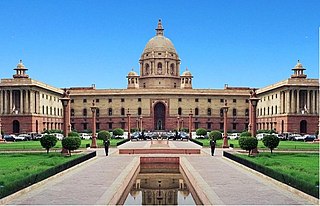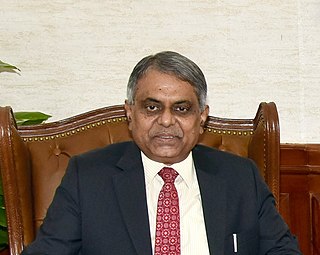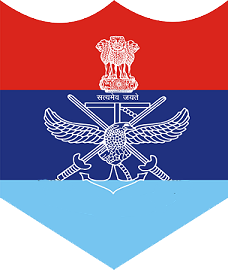
The Indian Police Service or IPS, is an All India Service for policing. It replaced the Indian Imperial Police in 1948, a year after India became independent from Great Britain.

The Government of India, often abbreviated as GoI, is the union government created by the constitution of India as the legislative, executive and judicial authority of the union of 29 states and seven union territories of a constitutionally democratic republic. It is located in New Delhi, the capital of India.

A district magistrate, often abbreviated to DM, is an Indian Administrative Service (IAS) officer who is the senior most executive magistrate and chief in charge of general administration of a district in India. Since district magistrates are responsible for collection of land revenue in the district, the post is also referred to as the district collector, and as the office-bearer works under the supervision of a divisional commissioner, the post is also known as deputy commissioner.

Indian Forest Service (IFS) is one of the three All India Services of the Government of India. The other two All India Services being the Indian Administrative Service (IAS) and the Indian Police Service (IPS). It was constituted in the year 1966 under the All India Services Act, 1951 by the Government of India.

The Ministry of Home Affairs (MHA) or Home Ministry is a ministry of the Government of India. As the interior ministry of India, it is mainly responsible for the maintenance of internal security and domestic policy. The Home Ministry is headed by Union Minister of Home Affairs Rajnath Singh.

Gazetted officers include all the Indian Police Service officers which are Class I officers of the cadre and all State Police Services officers of and above the rank of inspector of police and State Police forces respectively. All are arranged in a hierarchical order.

The Government of Uttar Pradesh is a democratically elected state government in the North Indian state of Uttar Pradesh with the governor as its appointed constitutional head of the state by the President of India. The Governor of Uttar Pradesh is appointed for a period of five years and appoints the chief minister and his or her council of ministers, who are vested with the executive powers of the state. The governor remains a ceremonial head of the state, while the chief minister and his or her council are responsible for day-to-day government functions. The state of Uttar Pradesh's influence on Indian politics is paramount as it sends the largest number of members of parliament to both the Lok Sabha and the Rajya Sabha.
Central Secretariat Service is the administrative civil service under Group A and Group B of the Central Civil Services of the executive branch of the Government of India. They are governed by Central Secretariat Service Rules of 1962, which has been issued under the powers of Article 309 of the Constitution of India.
The Civil Services refer to the career bureaucrats who are the permanent executive branch of the Republic of India. The civil service system is the backbone of the administrative machinery of the country.

The Cabinet Secretary is the top-most executive official and senior-most civil servant of the Government of India. The Cabinet Secretary is the ex-officio head of the Civil Services Board, the Cabinet Secretariat, the Indian Administrative Service (IAS), and all civil services under the rules of business of the government.
Joint Secretary is a post under the Central Staffing Scheme and the third highest non-political executive rank in Government of India. The authority for creation of this post solely rests with Cabinet of India.

The Tamil Nadu Civil Service (TNCS) is the state civil service and bureaucracy in the Indian state of Tamil Nadu. Recruitment for the service is based on the results of an annual competitive examination.
Secretary to the Government of India, often abbreviated as secretary, GoI, or, simply as secretary, is a post and a rank under the Central Staffing Scheme of the Government of India. The authority for the creation of this post solely rests with the Union Council of Ministers.

The Defence Secretary is the administrative head of the Ministry of Defence. This post is held by a senior Indian Administrative Service of the rank of secretary to the Government of India. The current Defence Secretary is Sanjay Mitra.
Additional Secretary is a post and a rank under the Central Staffing Scheme of the Government of India. The authority for creation of this post solely rests with Cabinet of India.

Provincial Civil Service, often abbreviated to as PCS, is the administrative civil service under Group A state service of the executive branch of the Government of Uttar Pradesh. It is also the feeder service for Indian Administrative Service in the state.

T. S. R. Subramanian &Ors. versus Union of India and Ors., an Indian public interest civil writ petition filed before the Supreme Court of India and decided in October 2013, is considered one of the landmark cases in Indian legal history.

Provincial Police Service, often abbreviated to as PPS, is the Group A state civil service for policing of Uttar Pradesh Police. It is also the feeder service for Indian Police Service in the state.

















